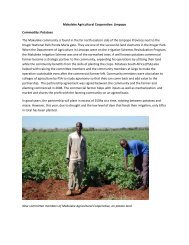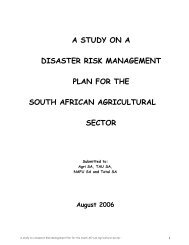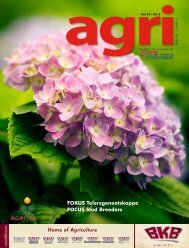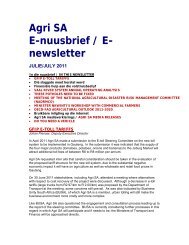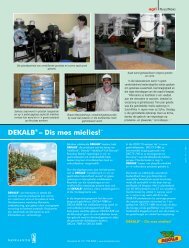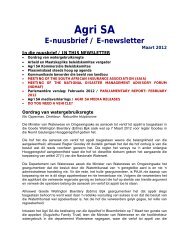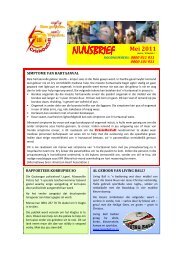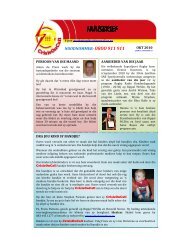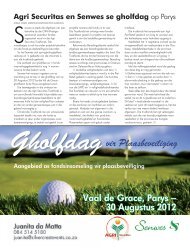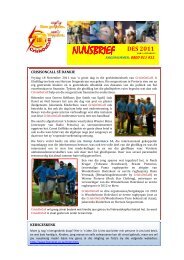Agri AUG SEPT 09.indd - Agri SA
Agri AUG SEPT 09.indd - Agri SA
Agri AUG SEPT 09.indd - Agri SA
You also want an ePaper? Increase the reach of your titles
YUMPU automatically turns print PDFs into web optimized ePapers that Google loves.
agri<br />
Fokus / Focus<br />
NEW SOLUTION TO <strong>SA</strong>’S VERMIN PROBLEM<br />
This year, the food industry will have to comply with<br />
HACCP in order to be issued permits to trade. This<br />
means that, with health regulations becoming more<br />
stringent, business owners and farmers must find<br />
ways of solving their vermin problems.<br />
New, electromagnetic technology which has helped<br />
Australia deal effectively with its mice, rat and other pest<br />
problems has been launched in South Africa where rodent<br />
populations are now reaching epidemic proportions.<br />
Plug-In Pest Free has been heralded as the new ‘pied piper in<br />
town’. It eradicates all rats, mice and cockroaches from buildings<br />
and is the most cost-effective way of controlling the problem. The<br />
unit plugs into the wall socket and creates an electro-magnetic<br />
After this it was identified by Mr Ian<br />
Millar, a taxonomist of the National<br />
Insect Collection in Pretoria. The<br />
discovery of the Pomegranate whitefly<br />
(Siphoninus phillyreae) is a further headache<br />
for South African fruit farmers and<br />
gardeners. Recently Prof Giliomee’s<br />
discovery of the exotic Woolly whitefly<br />
(Aleurothixus floccosus), which attacks<br />
citrus, also made the headlines.<br />
Contrary to what their name suggests,<br />
these insects are not flies but are rather<br />
more closely related to scale insects and<br />
aphids. The adults look like tiny moths<br />
and fly around rapidly while at the<br />
younger stages they are suctioned onto<br />
the underside of leaves. According to<br />
Prof Giliomee, these whiteflies have the<br />
potential to become very troublesome and<br />
to do a great deal of damage.<br />
When they arrived in California in 1988,<br />
the whiteflies affected many shrubs and<br />
trees so badly that the plants lost all their<br />
leaves and the harvest of fruit trees was<br />
reduced.<br />
“Young pear trees even died as a result of<br />
repeated exfoliation,” Prof Giliomee says.<br />
“In cities and towns, the sticky honeydew<br />
that is secreted during the sap-sucking<br />
early stages, landed on cars and on people<br />
and was even carried into houses by the<br />
wind to make carpets and furniture sticky<br />
too.<br />
“It was intolerable and the pest was only<br />
brought under control in California when<br />
parasites were imported,” he said.<br />
The Pomegranate whitefly originates in<br />
countries around the Mediterranean Sea<br />
like Spain, Italy, Israel and Egypt where,<br />
apart from garden shrubs, it attacks a<br />
wide range of fruit trees. It later spread<br />
to India, Iran and New Zealand. A great<br />
number of pomegranate cuttings have<br />
been imported into South Africa from<br />
Israel and India in the past few years. Prof<br />
field around the wiring of the premises. Its primary benefit<br />
to the agricultural industry would be to protect storehouses,<br />
barns, warehouses and packing plants from rodents eating the<br />
harvested grain, bailed produce, or seeds and supplements.<br />
The Plug-In Pest Free unit has been passed by both <strong>SA</strong>BS and<br />
HACCP (Hazard Analytical Critical Control Point) and has been<br />
successfully tested in various scientific double blind tests.<br />
The system works in ridding grain and seed storage areas of rats<br />
and prevents them gnawing through wires and floors, paper and<br />
packaging etc., in buildings.<br />
It is also environmentally friendly and saves money. Pets are not<br />
exposed to toxic and poisonous rat pellets, and rats that have<br />
eaten the pellets won’t poison barn owls. For more information,<br />
please contact Will Gubb on 021 464 1144 or 071 602 5793. a<br />
The exotic Pomegranate or Ash whitefly, which can severely damage garden shrubs, apple and pear trees, olive trees,<br />
citrus and pomegranate trees, was noticed recently for the first time in South Africa by Professor Jan Giliomee, a<br />
research associate at the Department of Botany and Zoology at Stellenbosch University.<br />
Another harmful whitefly establishes<br />
itself in South Africa<br />
Colonies of the immature Pomegranate<br />
whitefly attached to leaves by suction.<br />
agri Augustus/August • September 2009 44<br />
PHOTO CREDIT: STELLENBOSCH UNIVERSITY/ANTON JORDAAN<br />
Giliomee surmises that the new whitefly<br />
entered the country with plant material<br />
that was brought in illegally and did<br />
not go through the quarantine process<br />
required by law.<br />
Prof Giliomee says he saw the insect here<br />
for the first time on a wild olive tree in the<br />
garden of his beach house at Vermont<br />
on the Overberg coast. A month later he<br />
received heavily infested pomegranate<br />
leaves from a farmer at Halfmanshof near<br />
Porterville, who suspected that it was the<br />
Woolly whitefly. Mr Millar then established<br />
that they were, however, also examples of<br />
the new arrival.<br />
“The fact that the appearance of these<br />
whiteflies is already so widespread indicates<br />
that they have been in the country<br />
for some time and can therefore not be<br />
eradicated,” he stated.<br />
“The question is now whether the numbers<br />
are going to remain relatively low<br />
or whether the situation in California is<br />
going to repeat itself here,” Prof Giliomee<br />
said. “It must now be established whether<br />
wasps that prey on the pest are present<br />
here and, if not, they must be imported<br />
urgently.”<br />
No remedies have yet been tested for<br />
combating the whitefly. a<br />
Engela Duvenage<br />
For more information, please contact Prof<br />
Jan Giliomee, (021) 808-2718 or jhg@sun.<br />
ac.za




